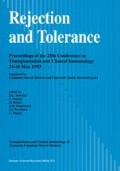Abstract
The field of organ transplantation has grown dramatically over the last 35 years, and one of the key advances that has led to this growth is the introduction of Cyclosporin A as an effective immunosuppressive agent (1). So successful has allotransplantation become with improvement in terms of survival (2), quality of life (3, 4) and cost benefit (5) that ever greater numbers of patients are being referred by physicians for consideration of transplantation. This has resulted in a relative shortage in the number of donor organs and in no area is this more marked than in the field of cardiopulmonary transplantation. In the United Kingdom 454 patients received thoracic organ transplants in the year ending 31 December 1992 while the waiting list grew to 706 patients (6) and the number of patients passing through the assessment procedure is more than three times that number. 25 — 30% of patients waiting for heart or lung transplants die before suitable organs become available for them.
Access this chapter
Tax calculation will be finalised at checkout
Purchases are for personal use only
Preview
Unable to display preview. Download preview PDF.
References
Calne R, Rolles K, White D, et al. Cyclosporin A initially as the only immunosuppressant in 34 recipients of cadaveric organs: 32 kidneys, 2 pancreases and 2 livers. Lancet 1979;(ii):1033–1036.
Kaye M. The registry of the International Society for Heart and Lung Trnsplantation: Ninth official report-1992. J Heart Lung Trans 1992;11(4):599–606.
Caine N, O’Brien V. Quality of life and psychological aspects of heart transplantation. In: Wallwork J, ed. Heart and Heart-Lung Transplantation. Philadelphia: W B Saunders Company, 1989: 389–422.
Caine N, Sharpies L, English T, Wallwork J. Prospective study comparing quality of life before and after heart transplantation. Trans Proc 1990;22(4):1437–1439.
Buxton M, Acheson R, Caine N, Gibson S, O’Brien V. Costs and benefits of heart transplant programmes at Harefield and Papworth hospitals: Final report. In: London: HMSO, 1985.
UKTS Users Bulletin: Winter 1992/93. In: Bristol, UKTSSA, 1993.
Hoffenberg R. Working party on the supply of donor organsfor transplantation. In: London: HMSO, 1987.
Gore S, Hinds C, Rutherford A. Organ donation from intensive care units in England. Brit Med J 1989;299:1193–1197.
Fischel RJ, Kim W, Cahill D, Matas AJ. The cellular response to xenotransplantation. Curr Surg 1990;47(5):345–7.
Platt J, Vercolotti G, Lindman B, Oegema T, Bach F, Dalmaso A. Release of heparan sulfate from endothelial cells. J Exp Med 1990;71:1363–1368.
Reding R, Maldague P, Massion P, Lambotte L, Otte J. Differential effect of plasma exchange and platelet activating factor antagonist WEB 2170 on hyperacute vascular rejection of discordant xenografts in rodents: preliminary results. Min Chir 1991;46:167–168.
Pearce EJ, Hall BF, Sher A. Host-specific invasion of the alternative complement pathway by schistosomes correlates with the presence of a phospholipase C-sensitive surface molecule resembling human decay accelerating factor. J Immunol 1990;144(7):2751–2756.
Kotwaj GJ, Moss B. Vaccinia virus encodes a secretory polypeptide structurally related to complement control proteins. Nature 1988;335:176–178.
Oglesby TJ, White D, Tedja I, et al. Protection of mammalian cells from complement-mediated lysis by transfection of human membrane cofactor protein and decay accelerating factor. Trans Ass Am Phys 1991;104:164–172.
White D, Oglesby TJ, Liszewski K, et al. Expression of human decay accelerating factor or membrane cofactor protein genes on mouse cells inhibits lysis by human complement. Trans Proc 1992;24(2):474–476.
White DJG. Transplantation of organs between species. Int Arch All Immunol 1992;98:1–5.
Platt JL, Bach FH. The barrier to xenotransplantation. Transplantation 1991;52(6):937–47.
Author information
Authors and Affiliations
Editor information
Rights and permissions
Copyright information
© 1994 Springer Science+Business Media Dordrecht
About this chapter
Cite this chapter
Dunning, J., White, D., Wallwork, J. (1994). Transgenic pigs as potential donors for xenografts. In: Touraine, J.L., Traeger, J., Bétuel, H., Dubernard, J.M., Revillard, J.P., Dupuy, C. (eds) Rejection and Tolerance. Transplantation and Clinical Immunology, vol 25. Springer, Dordrecht. https://doi.org/10.1007/978-94-011-0802-7_14
Download citation
DOI: https://doi.org/10.1007/978-94-011-0802-7_14
Publisher Name: Springer, Dordrecht
Print ISBN: 978-94-010-4345-8
Online ISBN: 978-94-011-0802-7
eBook Packages: Springer Book Archive

